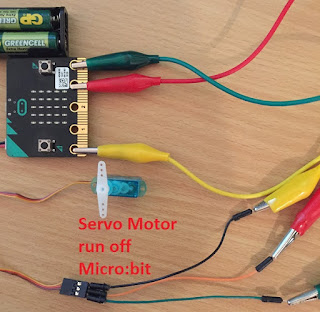Micro:bit with Servo Motor

The above image shows a Micro:bit hardwired into a servo motor which is just about its limit. Block Editor Coding: Servo Connection example: Connecting The BBC micro:bit To The Servo: The servo has a three wire connector. The brown wire is ground, the red wire is positive and the orange wire is the signal wire. The BBC micro:bit will send instructions to the servo from the P0 pin via the servo's signal wire. Push the BBC micro:bit into the Breakout Board or use alligator clips. Use the 3 x Jumper wires and 3 alligator clips to connect the Servo to the micro:bit, the table below shows how the connections are made. BBC micro:bit to Mini Servo 3V Pin. connects to Red servo wire GND. connects to Brown servo wire P0 Pin. connects to Orange servo wire More information may be found at: https://www.kitronik.co.uk/blog/using-bbc-microbit-control-servo/


